Theropoda
- Nearly all are bipedal: forelimbs shorter than hind limbs
- Claws on all fingers and toes
- Fairly long S-shaped necks
- Relatively large head (most)
- Hollow limb bones
- Vertebrae with spaces for air sacs
- 4 toes per hind foot (outer toe lost), with one toe often vestigial (does not reach ground)
- 4 or fewer digits on fore limbs; one is usually somewhat opposable
|
|
Basal Theropods
- Various primitive groups (paraphyletic grouping)
- Typically have 4 fingers per hand (but one may be vestigial and not visible externally)
- Small to medium-sized; slender build
- Tail somewhat flexible
|
Coelophysidae
- A primitive group of theropods
- 4 fingers per hand (an ancestral trait)
- Mostly small, with a slender build
- Skull usually fairly elongated
- Known primarily from Triassic Period
| 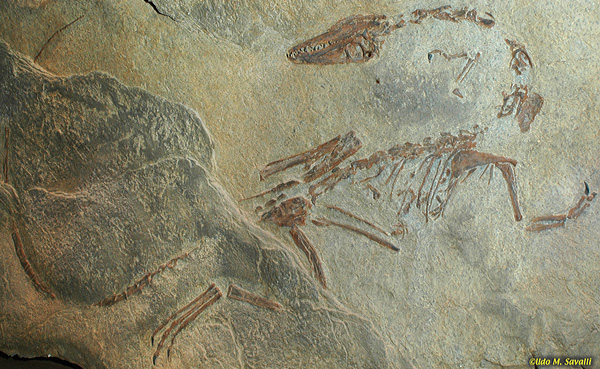
Coelophysis fossil, Late Triassic Period, New Mexico (WDC [Museums are identified at bottom of page])
|

View Larger Image
|
Dilophosauroids
- 1 finger reduced (appear to have only 3)
- Medium-sized, with moderately slender build
- Thin bone crests on head
- Known primarily from early Jurassic Period
- Paraphyletic: Dilophosaurus more closely related to ceratosaurs and tetanurans (below)
| 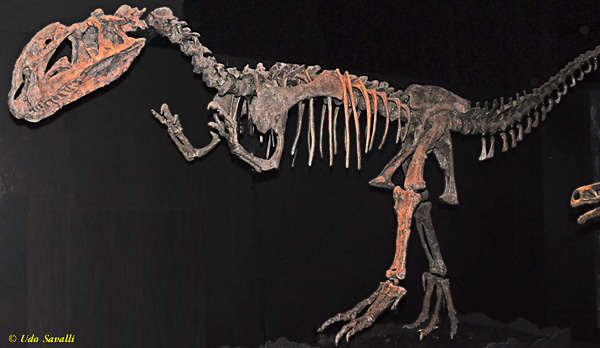
Sinosaurus fossil, Early Jurassic Period, China
|

View Larger Image
|
|
Ceratosauroids
- Relatively primitive, with four fingers (but one may be vestigial)
- Morphologically diverse, with varied body sizes
- Mostly found in southern hemisphere
|
Ceratosauridae
- 4 fingers per hand
- Medium to large size
- Fairly typical proportions for large predatory dinosaurs
- Several small horns on head
|
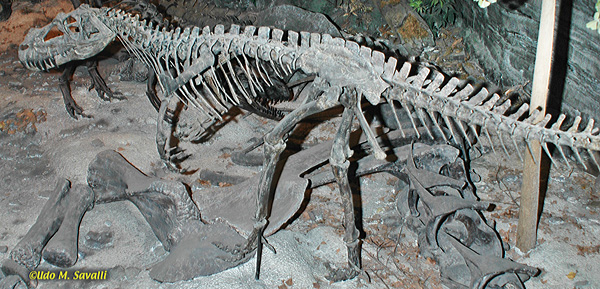
Ceratosaurus skeleton, Late Jurassic Period, North America, Europe, Africa (MAL)
|

View Larger Image
|
Noasauridae
- Small, slender dinosaurs
- Head small
- Some with projecting teeth (for fish catching?)
- Others were toothless
|
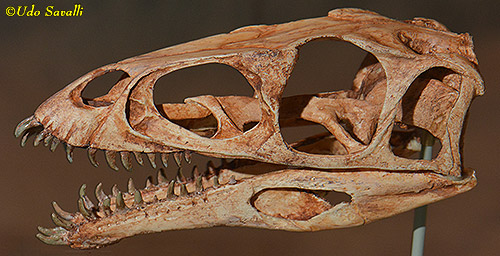
Masiakasaurus knopfleri skull cast, Late Cretaceous Period, Madagascar (CFM)
|
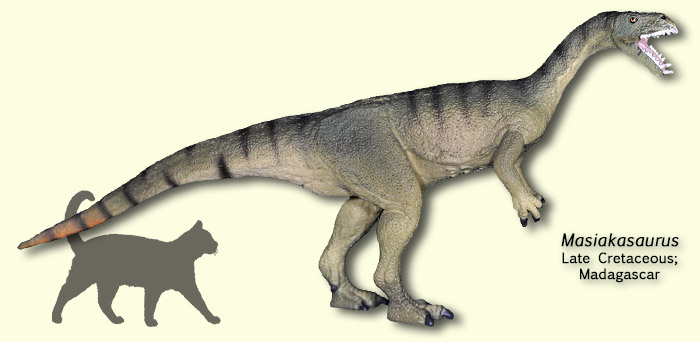
|
Abelisauridae
- Forelimbs greatly reduced, vestigial, but with 4 fingers
- Medium to large size
- Skulls are deep, and fairly short in derived forms
- Crests and bumps on head or face are typical
| 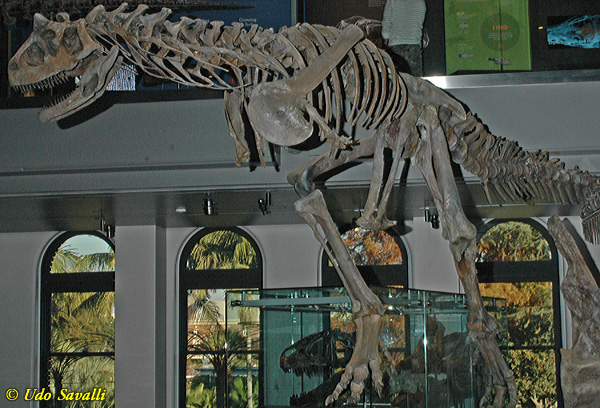
Carnotaurus skeleton, Late Cretaceous Period, Argentina (LAMNH)
|
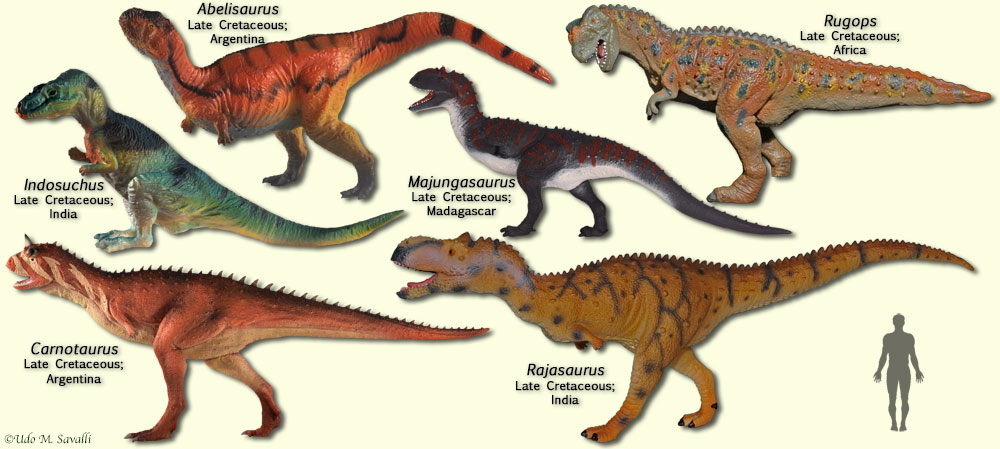
View Larger Image
|
|
Tetanurans
- All subsequent theropods belong to the clade Tetanurae
- 3 Fingers (or fewer) per hand
- Tail relatively stiff
- Body size varies
|
"Carnosaurs"
- Carnosaur was a name applied to most large predatory dinosaurs
- Phylogenetic analysis indicates Carnosaurs are not monophyletic, so the name is falling out of use
- Large size with fairly typical shapes for large predatory dinosaurs
- For convenience, and since there are few external differences, we will combine most typical large carnivores, such as the Allosauroids and Megalosaurs, into a general "Carnosaur" grouping in lab
|
Megalosauridae
- Megalosaurs are medium to large generalized theropods
- Few obvious specializations; lack crests or horns on head
- Large claw on thumb
- Includes Megalosaurus, the first named dinosaur
- Formerly included with other large theropods in the "Carnosauria"
- Some fossils of juvenile dinosaurs (formerly in family Compsognathidae) are now recognized as juvenile megalosaurs (adults unknown)
- At least some had feathers as juveniles (e.g. Sciurumimus)
| 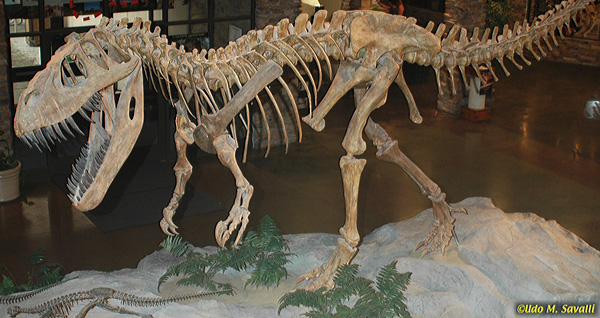
Torvosaurus skeleton, Late Jurassic Period, North America (MAL)
|
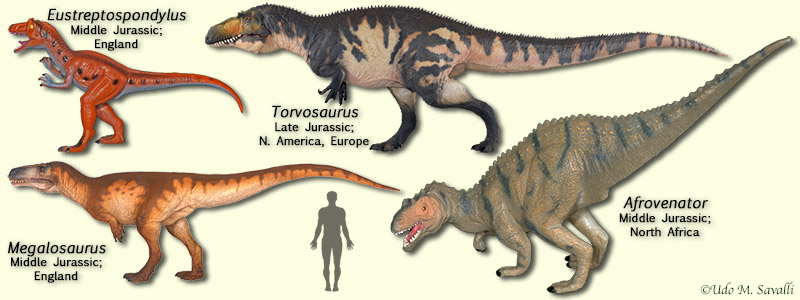
View Larger Image
Our Changing Views of Dinosaurs: Megalosaurus
See lab manual Exercise 17 for more information

View Larger Image
|
The Problem With Juveniles: Megalosaurs & Compsognathids
See lab manual Exercise 17 for more information

View Larger Image
|
|
Spinosauridae
- Large to very large size
- Long, narrow snout with enlarged tip
- Small centrally-located crest on forehead
- Teeth conical, without serrations
- Most likely were piscivorous (fish eaters); some where semi-aquatic (the only known aquatic dinosaurs)
| 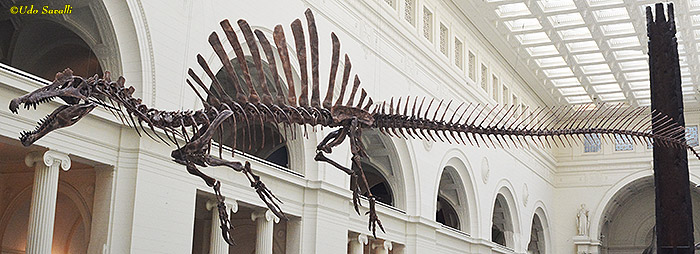
Spinosaurus aegyptiacus skeleton, Late Cretaceous Period, North Africa (CFM)
|
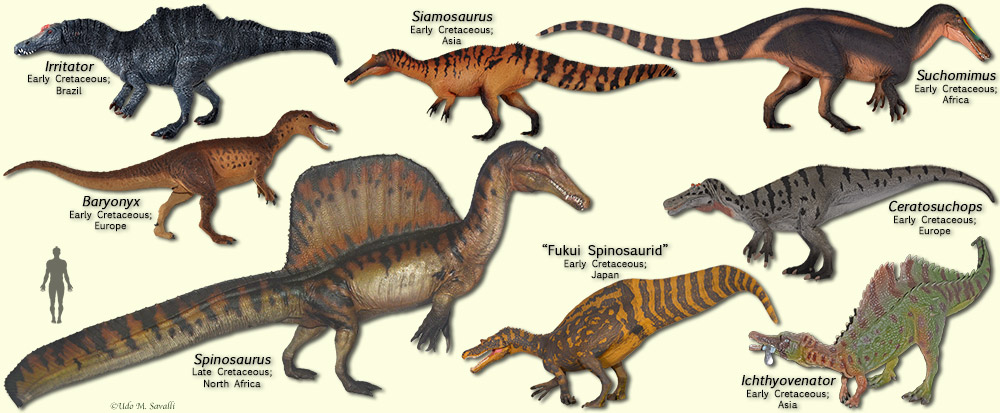
View Larger Image
Our Changing Views of Dinosaurs: Spinosaurus
See lab manual Exercise 17 for more information

View Larger Image
|
|
Allosauroids
- A large, diverse group of generalized predators
- Mostly large to very large size
- Generally have somewhat elongated skulls with large orbits
- Many have ridge or horn above eye (but not unique to this group)
| 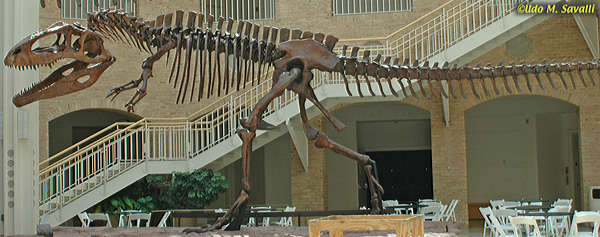
Giganotosaurus skeleton, Late Cretaceous Period, Argentina (FMNH)
|

View Larger Image
|
|
Coelurosauria
- All subsequent tetanuran theropods belong to the clade Coelurosauria
- Enlarged sacrum (the vertebrae between the pelvic bones)
- Stiffened tail
- Tibia (lower leg) longer than femur (upper leg)
- Perhaps all had some sort of feathers or protofeathers
- Ancestrally small-sized, and most were small-medium sized, but a few did evolve very large sizes
|
Basal Coelurosaurs
- Small, agile predatory dinosaurs
- Proportionately long tails
- At least some (or all?) had simple proto-feathers
- Some of these were formerly placed in the family Compsognathidae, which is likely no longer valid (see Megalosaurs, above)
- This group is probably not monophyletic
| 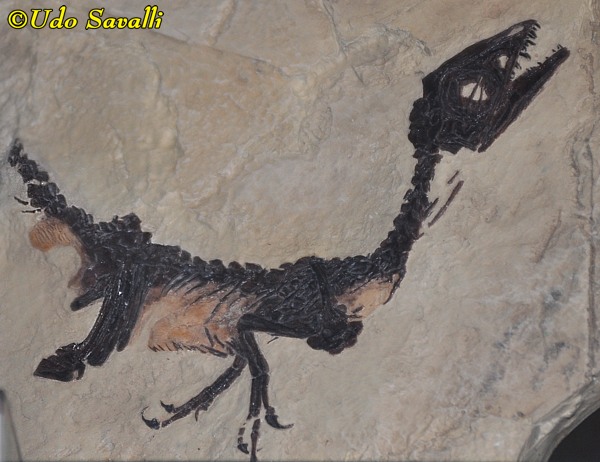
Scipionyx juvenile fossil, Early Cretaceous Period, Europe (BHI)
|
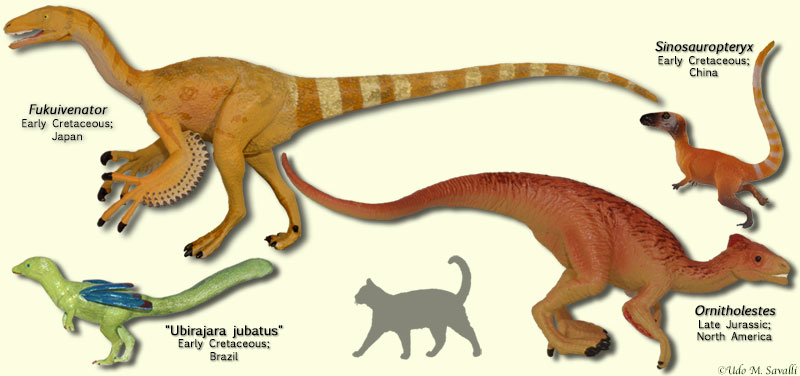
View Larger Image
|
|
Tyrannosauroidea
- United by various subtle skeletal characteristics
- Predatory theropods, but variable in proportions
- Simple protofeathers were probably ancestral in this group (but may have been secondarily lost in some)
|
Basal Tyrannosauroids
- Relatively primitive, similar to other basal coelurosaurs
- Small to medium size
- 3 fingers per hand (like most other theropods)
- Some known to have had feathers
| 
Tanycolagreus skeleton, Late Jurassic Period, North America (MoAL)
|

View Larger Image
Megaraptors
- Medium sized, slender build
- Long, narrow skulls
- Long arms with 3 fingers; enlarged thumb claw
- Poorly known & only recently recognized as belonging in the Tyrannosauroids
| 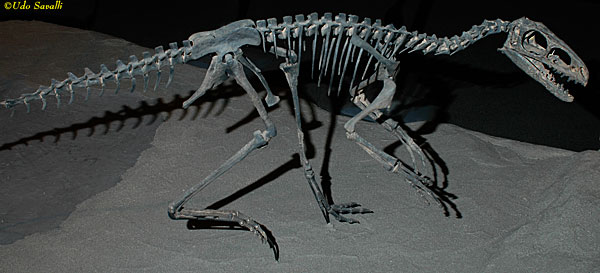
Suskityrannus skeleton, Late Cretaceous Period, NM (AZMNH)
|
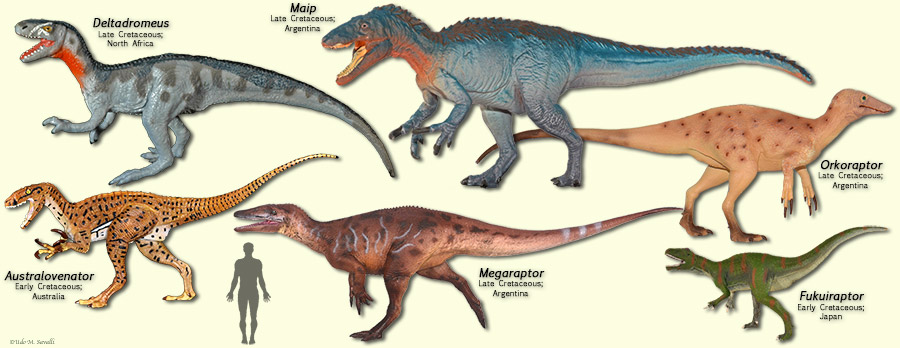
View Larger Image
|
Tyrannosauridae
- Most derived group from the latest Cretaceous
- Large size
- Proportionately large head
- Greatly reduced arms with only 2 fingers
| 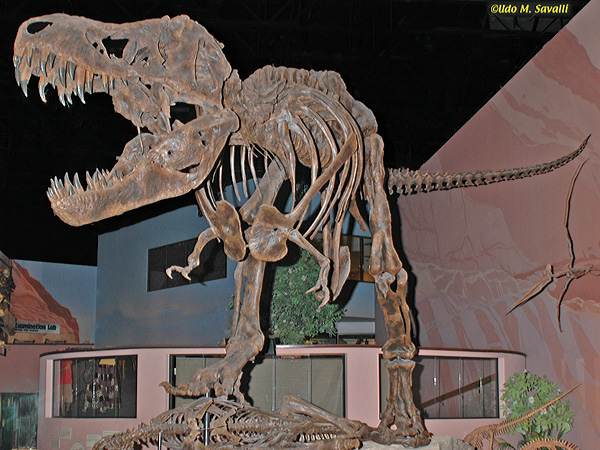
Tyrannosaurus skeleton, Late Cretaceous Period, North America (MAL)
|
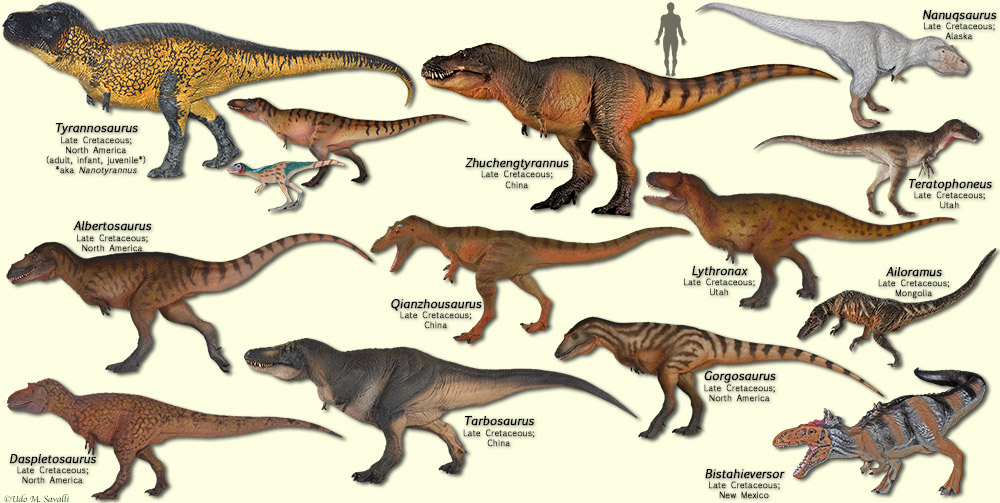
View Larger Image
Our Changing Views of Dinosaurs: Tyrannosaurus
See lab manual Exercise 17 for more information

View Larger Image
|
Dinosaur Growth & Development: Tyrannosaurus
See lab manual Exercise 17 for more information

View Larger Image
|
Species Differences: Tyrannosaurs
See lab manual Exercise 17 for more information
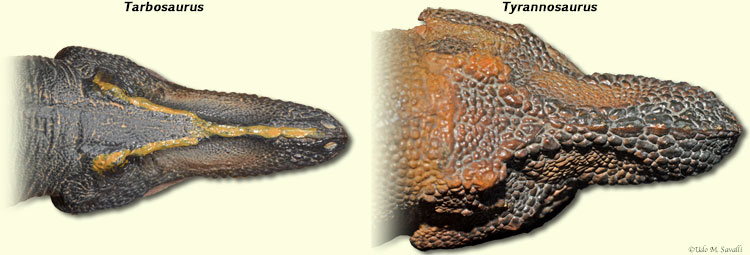
View Larger Image
|
Anagenesis: Daspletosaurus
See lab manual Exercise 17 for more information

View Larger Image
|
|
|
|
Maniraptoriformes
Ornithomimosauria
- Ostrich Dinosaurs
- Slender build, with long legs, long slender necks
- Small heads that were toothless in most (or with tiny peg-like teeth)
- Gastroliths present; probably herbivorous or omnivorous
- One species known to have feathers
| 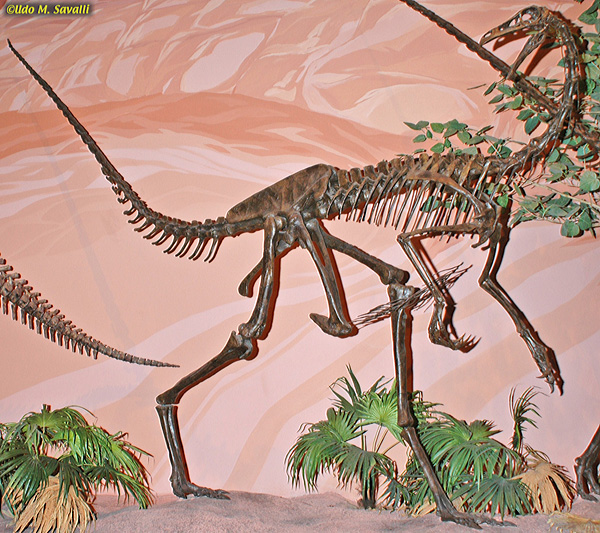
Struthiomimus skeleton, Late Cretaceous Period, North America (MAL)
|
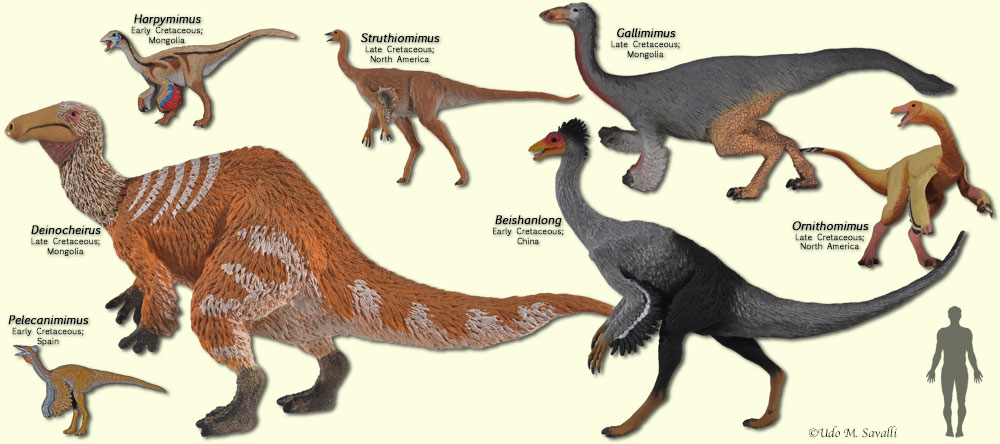
View Larger Image
|
Therizinosauroidea
- Very unusually shaped theropods
- Size varies from small to large
- Body broad and heavy, with wide hips and short tail
- Long necks with small heads
- Very long arms with enormous claws
- Probably herbivorous
- Loose, filamentous feathers known from one species
| 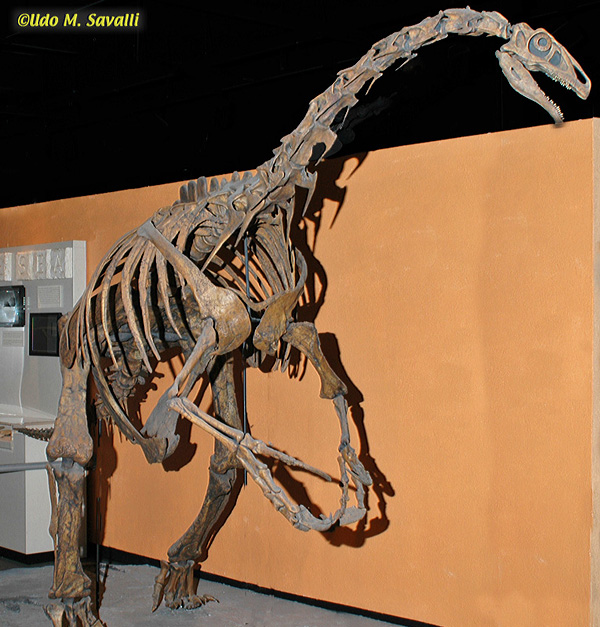
Nothronychus skeleton, Late Cretaceous Period, Southwestern USA (AZMNH)
|
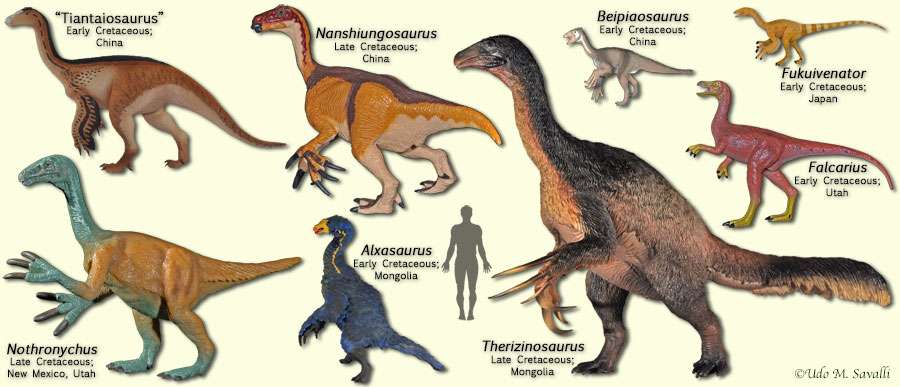
View Larger Image
|
Alvarezsauridae
- Small, with long legs and neck
- Small heads with tubular snout
- Very short but powerful arms
- Single, massive claw on each hand
- Loose, filamentous feathers known from one species
- May have been termite specialists
|
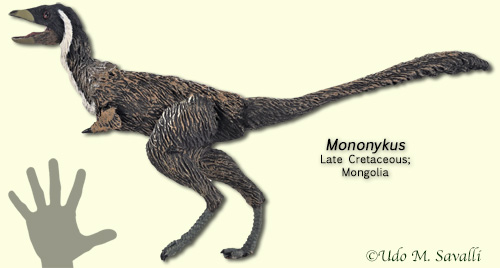
View Larger Image
|
Oviraptorosauria
- Long arms and short tails distinctive
- Most were small (but at least one large species)
- Very short skulls with (usually) toothless, parrot-like beak
- Some had prominent crests on their heads
- Feathers with flat vanes that may have functioned in display
- Diet uncertain: evidence for both herbivory and carnivory
| 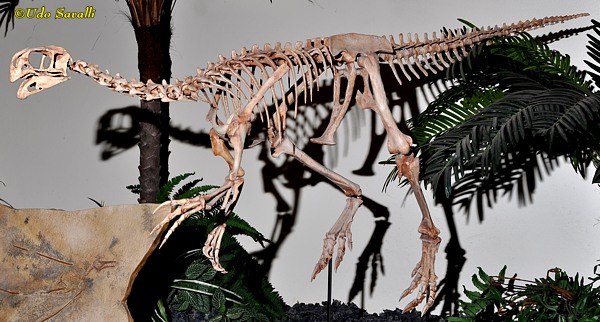
Conchoraptor skeleton, Late Cretaceous Period, Mongolia (DRC) |

View Larger Image
|
Scansoriopterygidae
- Eongated 3rd finger
- Finger and modified wrist bone support membranous wing in some
- Blunt, downcurved snout with large front teeth (projecting in some)
- Unique ribbon-like tail feathers
- Small size
- 4 known species
- Probably tree climbers and gliders
|
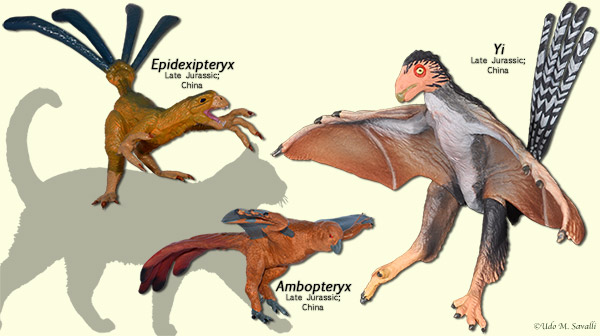
View Larger Image
|
Dromeosauridae
- Commonly referred to as "raptors"
- Very small to medium size
- Agile, with fairly long arms, long fingers
- Inner hind toe with a greatly enlarged, retractible slashing claw
- Skulls elongated
- Tails long and stiff
- Well developed feathers with vanes
- Some capable of gliding flight
| 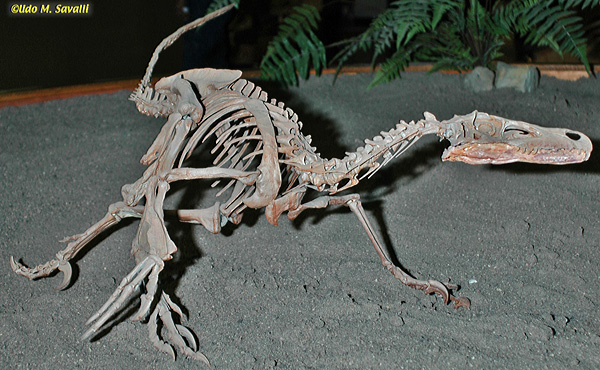
Velociraptor skeleton, Late Cretaceous Period, Asia (WDC)
|
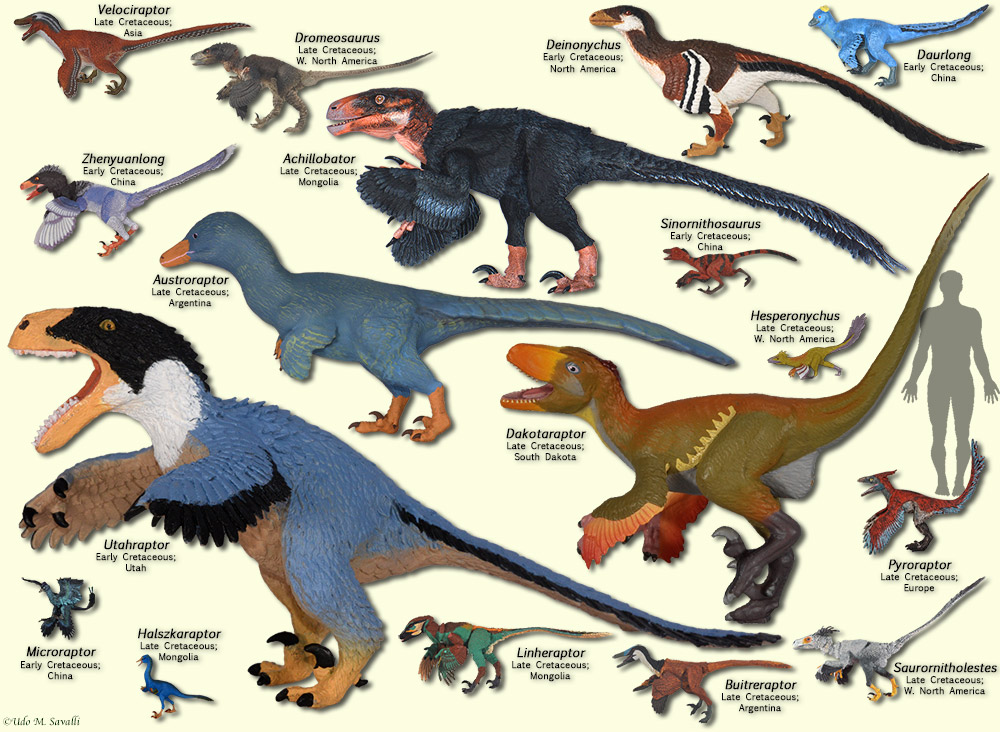
View Larger Image
Our Changing Views of Dinosaurs: Deinonychus
See lab manual Exercise 17 for more information

View Larger Image
|
|
Troodontidae
- Similar to the Dromeosaurs, but with smaller slashing claw
- Mostly small sized
- Smaller heads than Dromeosaurs with distinctive teeth
- Relatively large-brained
- Well developed feathers with vanes
| 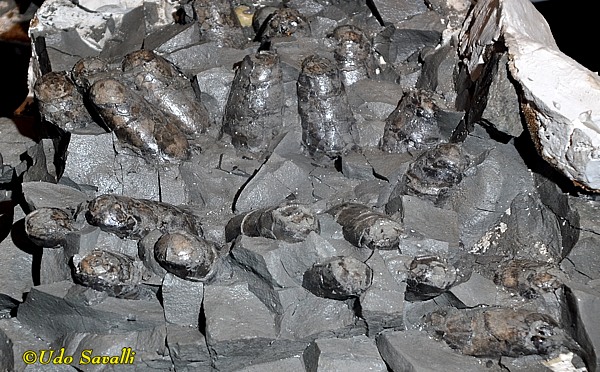
"Troodon" egg clutch, Late Cretaceous Period, MT (MotR)
|
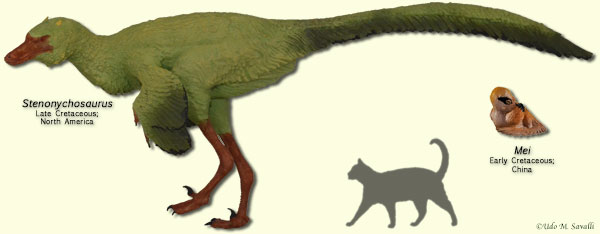
View Larger Image
|
Anchiornithidae
- Probably the sister-group to birds (Class Aves)
- Formerly thought to be related to Troodontidae
- Generally shorter-snouted than Troodontids or Dromeosaurs
- Mostly small sized
- Well developed feathers with vanes: very bird-like
|
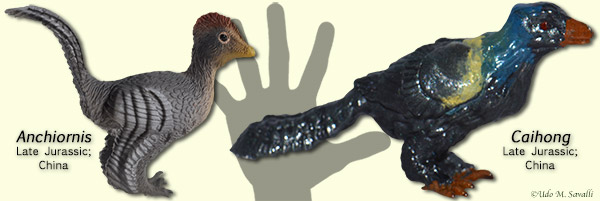
View Larger Image
|
|
|
Museums:
MAL = Museum of Ancient Life, Lehi, UT
WDC = Wyoming Dinosaur Center, Thermopolis
LAMNH = Los Angeles Museum of Natural History
FMNH = Fernbank Museum of Natural History, GA
AZMNH = Arizona Museum of Natural History, Mesa
BHI = Black Hills Institute Museum, Hill City, SD
MotR = Museum of the Rockies, Bozeman, MT
DRC = Dinosaur Resource Center, Woodland Park, CO
|
|












































